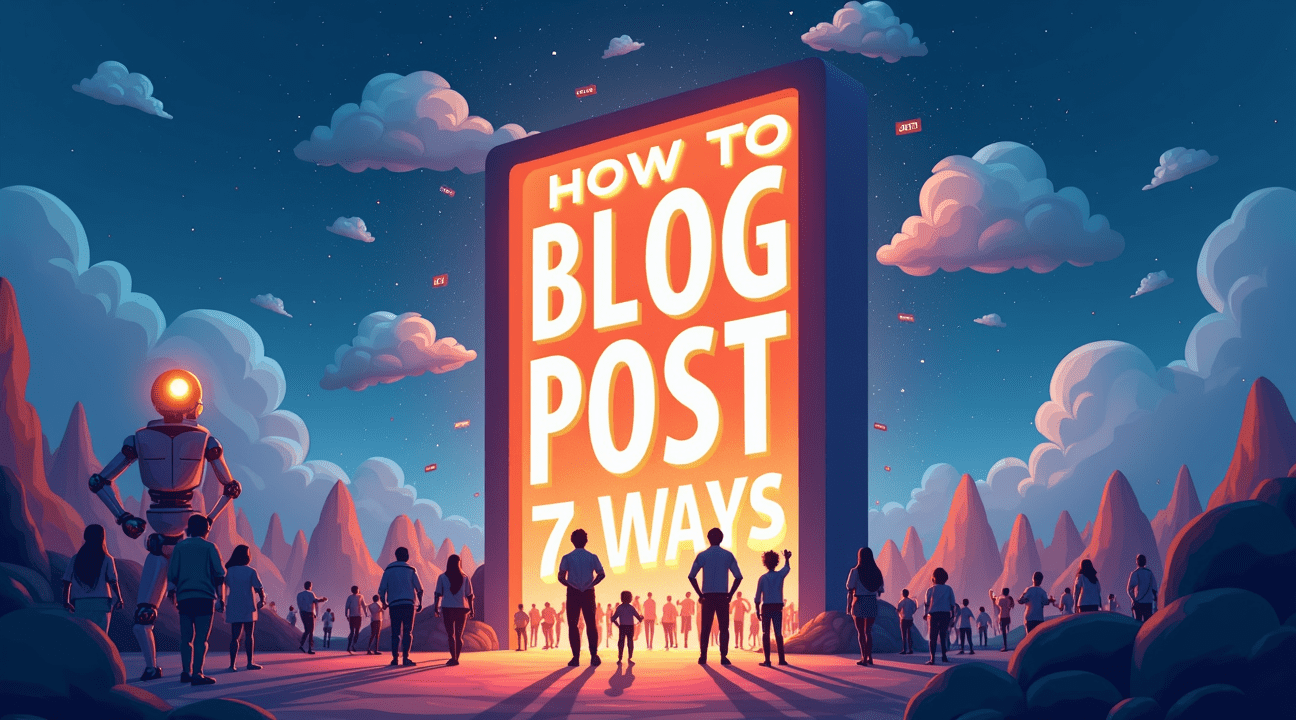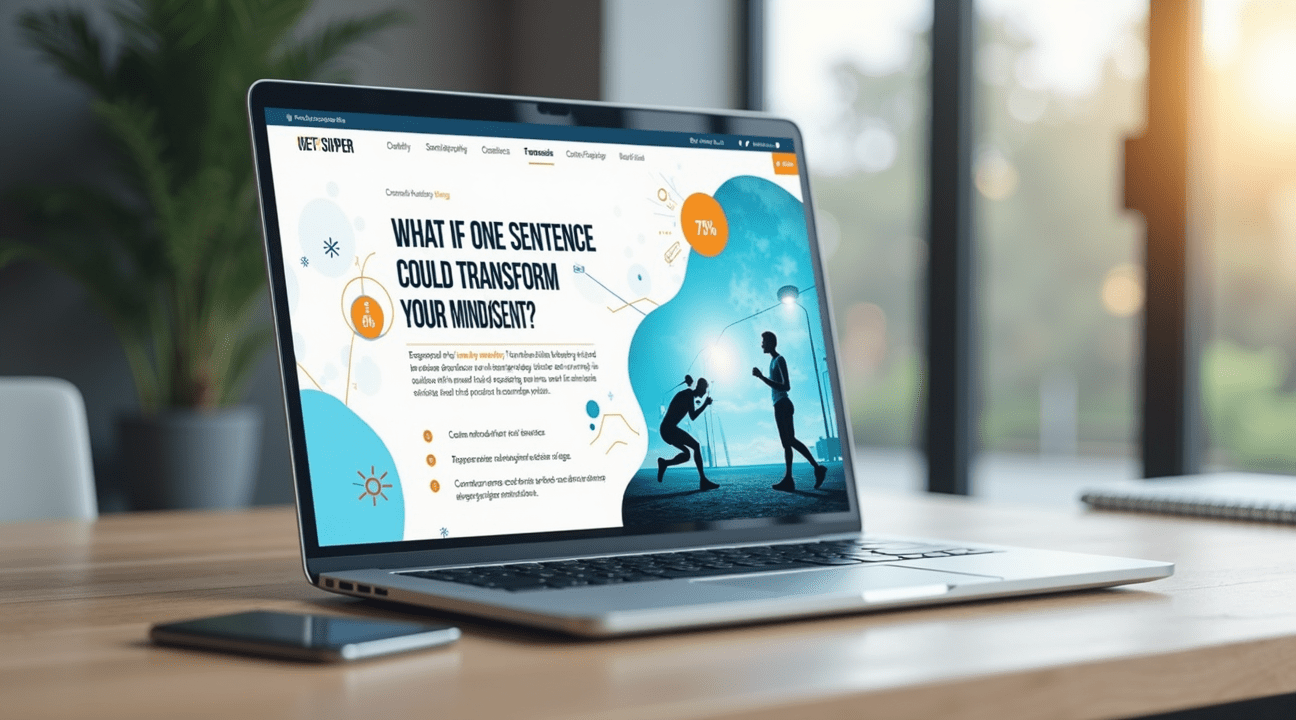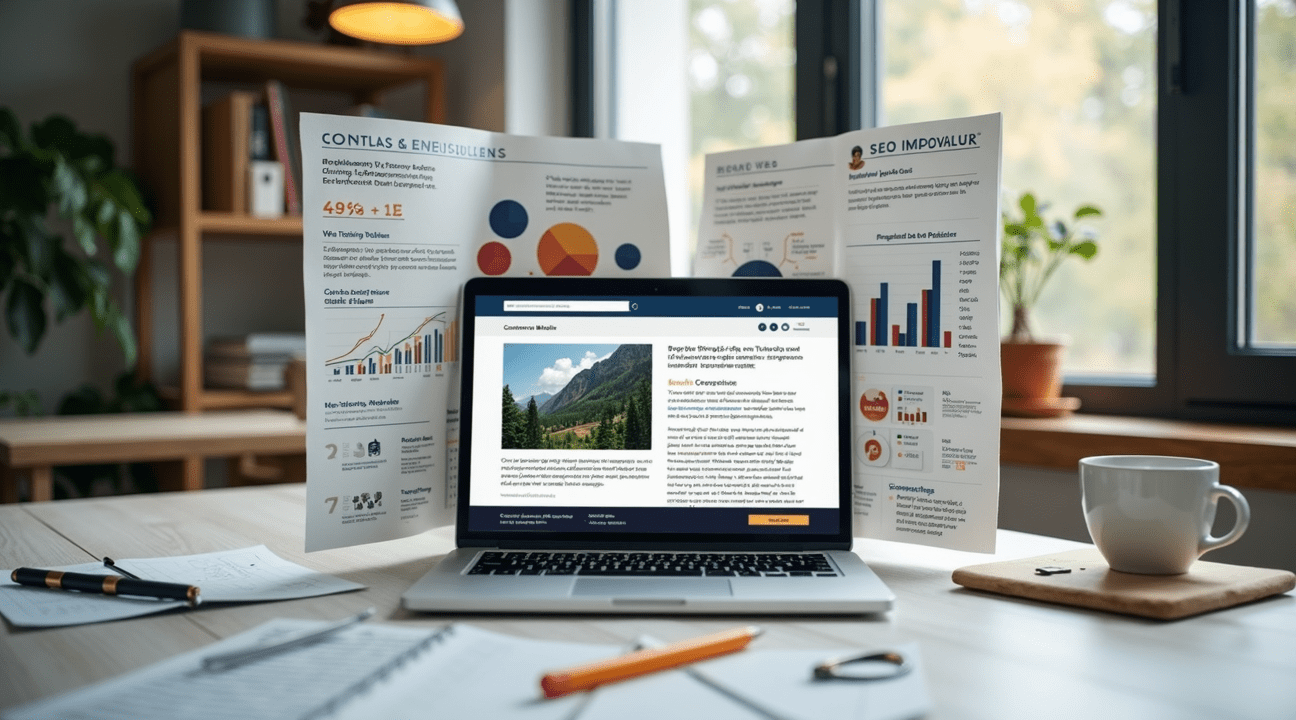Blog post titles wield tremendous influence over content performance, with studies demonstrating that five times more readers consume headlines compared to full articles. This critical understanding explains why strategic title development forms the foundation of powerful content marketing that boosts reader engagement and search engine rankings.
Key Takeaways
- Headlines drive 80% of success – Titles serve as both the primary engagement mechanism and the H1 element that search engines utilize for ranking signals.
- Psychology triggers increase clicks – Numbers, “how-to” phrases, and questions generate compelling headlines that tap into reader curiosity and promise concrete value.
- First 30 seconds determine retention – Engaging statistics, thought-provoking questions, and clear value propositions in openings capture readers before they decide to stay or leave.
- Strategic content organization improves performance – Using H2 and H3 headings, bullet points, and scannable formatting creates better user experience while supporting SEO objectives.
- Visual elements and error-free content build authority – Optimized images with proper ALT tags, strategic internal and external linking, and thorough grammar checking establish credibility with both readers and search engines.
Why Your Blog Post Title Determines 80% of Your Success Rate
I’ve learned through years of content creation that the title carries an enormous burden – it’s the make-or-break element that determines whether readers engage with your content. David Ogilvy’s research reveals that five times as many people read the headline as read the body copy, which means your title does the heavy lifting for your entire piece.
The Psychology Behind Click-Worthy Headlines
The most effective blog titles tap into specific psychological triggers that compel readers to click.
- Numbers immediately catch attention because they promise concrete, digestible information – “7 Ways to Improve Your Writing” performs better than “Ways to Improve Your Writing.”
- “How to” phrases signal practical value.
- Questions create curiosity gaps that readers feel compelled to fill.
I’ve found that compelling headings work because they set clear expectations. When someone sees “How to Write Better Blog Posts in 10 Minutes,” they know exactly what they’ll receive and how long it will take. This clarity reduces the mental friction that often prevents clicks.
Technical Impact on Search Engine Performance
Your blog post title functions as the H1 element, which search engines use as a primary ranking signal. This dual purpose means your title must satisfy both human readers and algorithmic requirements. Including relevant keywords naturally within your title helps search engines understand your content’s focus and match it with user queries.
Effective blog post structure begins with strategic keyword placement in titles. Instead of stuffing keywords awkwardly, I weave them into compelling phrases that maintain readability. For instance, “Blog Post Structure: 5 Essential Elements That Drive Engagement” incorporates the target keyword while remaining attractive to readers.
The H1 tag also carries significant weight in search rankings because it tells search engines what your page is fundamentally about. When your title accurately reflects your content and includes relevant search terms, you signal topical authority and improve your chances of ranking for related queries.
I’ve noticed that titles starting with power words like “Essential,” “Ultimate,” or “Complete” tend to perform well because they suggest comprehensive coverage. However, the key lies in delivering on whatever promise your title makes. Search engines track user behavior metrics, so if people click but immediately bounce back, your rankings suffer.
The relationship between blog titles and engagement extends beyond initial clicks. Strong titles set the tone for the entire reading experience and help establish trust with your audience. When readers find that your content matches your title’s promise, they’re more likely to engage with future posts and share your work with others.
Remember that your title is often the first and sometimes only impression potential readers have of your content. Making it count isn’t just about clever wordplay – it’s about creating an accurate preview that delivers compelling content while optimizing for discoverability and engagement.

How to Hook Readers in Your First 30 Seconds
I believe the opening moments of any blog post determine whether a reader stays or clicks away. Statistics show that visitors decide within 10-15 seconds whether content deserves their time, making those initial sentences absolutely critical for success.
Engaging statistics serve as powerful attention-grabbers that immediately establish credibility. For instance, starting with “75% of athletes credit motivational quotes for improved performance” creates instant intrigue while positioning the content as data-driven. Numbers carry weight and help readers understand the scope or importance of what they’re about to learn.
Thought-provoking questions work equally well because they activate the reader’s curiosity. Questions like “What if one sentence could transform your entire training mindset?” force readers to pause and consider possibilities. This mental engagement creates a psychological investment that encourages continued reading.
Creating Your Value Proposition
Relatable anecdotes bridge the gap between writer and reader by establishing common ground. I find that sharing brief, relevant stories about challenges or breakthroughs resonates deeply with audiences. Sports quotes often provide excellent anecdotal material because they capture universal themes of perseverance and achievement.
Setting clear expectations prevents disappointment and builds trust early in the reader relationship. Statements like “You’ll discover three proven strategies used by professional coaches” or “This guide contains actionable steps you can implement today” establish specific outcomes. Clear expectations also help readers decide quickly whether the content matches their current needs.
Your blog introduction should function as a preview that highlights the most compelling benefits readers will receive. Avoid vague promises and instead focus on concrete value propositions. Professional athletes understand this concept well – proven strategies matter more than empty motivation.
Content hooks work best when they align with your target audience’s specific interests and pain points. Research your readers’ challenges and craft openings that speak directly to their situations. Whether discussing business investments or personal development, relevance trumps creativity every time.
I recommend testing different hook styles to determine what resonates with your particular audience. Some readers prefer data-driven openings, while others respond better to emotional storytelling. Track engagement metrics like time on page and scroll depth to identify which approaches generate the strongest response patterns.
Remember that your opening paragraph should flow seamlessly into the main content. Avoid creating disconnects between your hook and the subsequent information. A well-crafted introduction serves as a bridge that guides readers smoothly from initial interest into deeper engagement with your material.

The Strategic Framework for Organizing Your Content Body
When I craft blog posts, I recognize that the body represents the core battleground where reader engagement either thrives or dies. The structure you choose directly impacts how visitors consume your information and whether they’ll stay long enough to convert into loyal followers.
Content organization begins with establishing clear information hierarchy through strategic heading placement. I always start each major section with H2 tags that capture the primary message in a scannable format. These headings act as roadmap markers, allowing readers to quickly identify relevant sections and jump to what interests them most. Each H2 should contain enough descriptive power that someone skimming your content understands the value proposition immediately.
Supporting details flow naturally under H3 subheadings, which I use sparingly but effectively. These secondary headings break down complex concepts within each major section, preventing overwhelming text blocks that cause readers to bounce. The key lies in maintaining logical flow between sections – each heading should connect seamlessly to the next, creating a narrative thread that guides visitors through your expertise.
Essential Elements That Transform Content Performance
Smart bloggers incorporate specific elements that dramatically improve both user experience and search engine visibility:
- Multimedia content placement that supports rather than distracts from your main points
- Internal links that guide readers to related valuable content on your site
- External links to authoritative sources that validate your claims
- Key takeaways highlighted through formatting or callout boxes
- Actionable steps presented in digestible chunks
- Relevant statistics woven naturally into your narrative
I’ve discovered that scannable content performs significantly better than dense paragraphs. Short sentences and varied paragraph lengths create visual breathing room while maintaining reader attention. Your conversational tone should feel like explaining concepts to a knowledgeable friend rather than lecturing from an academic podium.
Strategic keyword integration happens naturally when you focus on solving real problems. Rather than forcing terms artificially, I weave important phrases into headings and subheadings where they enhance clarity. This approach satisfies search algorithms while prioritizing human readability.
The blog post body structure I recommend follows a pyramid approach – start with broad concepts under your first H2, then narrow down to specific applications and examples. Each section should deliver immediate value while connecting to your overarching theme. Readers often scan headings first, so make them compelling enough to encourage deeper reading.
Multimedia elements deserve strategic placement rather than random insertion. I position images, videos, and infographics where they genuinely enhance understanding or provide visual breaks in text-heavy sections. These elements improve dwell time when they support your content rather than serving as mere decoration.
Internal linking strategy becomes powerful when you connect related topics naturally within your content flow. I reference sports quotes or other relevant content when it genuinely adds value to the current discussion. This approach keeps readers engaged within your content ecosystem while demonstrating topic authority.
Your information hierarchy should guide readers through increasingly valuable insights. Start with foundational concepts, progress through supporting evidence, and conclude major sections with actionable applications. This structure mirrors how people naturally process new information – from general understanding to specific implementation.
Content organization extends beyond just headings and formatting. I create logical bridges between sections using transitional phrases and connecting ideas that maintain narrative momentum. Each H2 section should feel essential to your overall message while standing alone as valuable content.
The conversational tone I maintain throughout the blog post body helps readers feel connected to the expertise being shared. Technical accuracy doesn’t require academic stuffiness – complex concepts become accessible through clear explanations and relatable examples.
Effective content bodies balance comprehensive coverage with focused messaging. Rather than trying to cover everything about a topic, I select the most valuable aspects that align with reader intentions and search queries. This focused approach creates more satisfying reading experiences while establishing clear expertise boundaries.
Your strategic framework should adapt to different content types while maintaining consistent organizational principles. Whether explaining technical processes or sharing industry insights, the same attention to logical flow and scannable structure will improve both user engagement and search performance.
Visual Elements That Boost Engagement and Search Rankings
I’ve witnessed countless content creators struggle with engagement, only to discover their missing ingredient wasn’t better writing—it was strategic visual implementation. A well-placed featured image immediately captures attention and sets the tone for your entire piece, while additional visuals scattered throughout maintain reader interest and break up dense text blocks.
The magic happens when you optimize these elements properly. ALT tags serve dual purposes: they make content accessible to screen readers and provide search engines with crucial context about your images. I recommend crafting descriptive ALT tags that naturally incorporate your target keywords without stuffing. File names deserve equal attention—replace generic “IMG_001.jpg” with descriptive names like “sports-quote-motivation-football.jpg” that search algorithms can interpret.
Essential Visual Optimization Strategies
Smart visual optimization goes beyond simply adding pictures. Consider these key elements that I’ve seen dramatically improve content performance:
- Featured images positioned at the top that immediately communicate your topic’s essence
- Complementary visuals every 300-500 words to maintain visual rhythm
- Captions that provide additional context and keyword opportunities
- Consistent sizing and quality standards across all imagery
- Strategic use of infographics or charts to present complex information
Professional formatting creates breathing room that readers crave. Generous white space prevents cognitive overload, while selective bolding guides the eye to crucial information. I’ve found that bullet points work exceptionally well for breaking down complex concepts into digestible pieces.
The Performance Connection
Enhanced visuals directly correlate with stronger engagement metrics. Search engines interpret longer time-on-page and reduced bounce rates as quality signals, boosting your rankings organically. When readers encounter well-formatted content with appropriate visual breaks, they’re significantly more likely to consume the entire piece.
Modern AI content discovery systems rely heavily on visual cues to understand and categorize content. Properly optimized images with descriptive ALT tags and strategic placement help these systems accurately index your material. This becomes particularly valuable when your content covers specialized topics like inspirational sports quotes or athlete stories.
I always ensure my visual elements serve multiple purposes: enhancing readability, supporting SEO objectives, and maintaining user engagement. The combination of strategic image placement, proper optimization techniques, and thoughtful formatting creates content that performs well both for human readers and search algorithms.

Building Authority Through Strategic Linking and Error-Free Content
Strategic linking serves as the backbone of strong SEO performance, creating connections that search engines use to understand content relevance and authority. I recommend implementing both internal and external linking strategies to maximize your blog’s potential for higher rankings and improved user experience.
Mastering Internal and External Link Strategies
Internal linking connects readers to related content within your website, keeping them engaged while signaling to search engines which pages hold importance. I suggest creating natural connections between posts that share similar topics or complement each other’s information. For example, when discussing sports achievements, you might link to inspirational sports content that reinforces your main message.
External links to authoritative sources provide context and credibility that search engines value highly. These connections demonstrate your commitment to providing well-researched information while supporting semantic SEO principles. Google’s algorithms recognize when content references trusted sources, interpreting this as a quality signal that can boost your rankings.
Consider these linking best practices for maximum impact:
- Use descriptive anchor text that clearly indicates what readers will find when clicking the link
- Link to high-authority domains with strong reputations in your industry
- Maintain a natural ratio of internal to external links throughout your content
- Ensure all linked content remains relevant to your main topic and adds genuine value
- Regularly audit your links to prevent broken connections that harm user experience
Strategic linking also supports E-E-A-T principles by demonstrating expertise through careful source selection and experience through thoughtful content connections. When you link to current sports news or athlete business ventures, you’re showing awareness of industry developments that matter to your audience.
Ensuring Content Quality Through Error Detection
Error-free content significantly impacts how search engines and readers perceive your blog’s credibility. I always recommend using comprehensive grammar checking tools like Grammerly to catch mistakes that might otherwise slip through manual proofreading. These tools identify grammatical errors, spelling mistakes, and awkward phrasing that can diminish your content’s professional appearance.
Plagiarism checking deserves equal attention in your content creation process. Google’s algorithms have become increasingly sophisticated at detecting duplicate content, often penalizing sites that publish unoriginal material. Running your content through plagiarism detection software before publication protects your site’s reputation while ensuring you maintain high standards of originality.
Originality extends beyond simply avoiding copied text. I focus on presenting unique perspectives, personal insights, and fresh angles on established topics. This approach not only satisfies plagiarism checkers but also provides genuine value that keeps readers returning for more content.
Quality assurance should include multiple review stages before publication. I recommend reading your content aloud to catch errors that automated tools might miss, particularly awkward sentence structures or unclear explanations. Pay special attention to technical terminology, proper names, and statistical information that requires accuracy for credibility.
Grammar and plagiarism checking tools work best when combined with human oversight. While these programs excel at identifying obvious errors, they can’t evaluate whether your content flows naturally or communicates effectively with your target audience. I always perform a final manual review to ensure the writing maintains a conversational tone while delivering authoritative information.
Search engines reward publishers who consistently deliver error-free, original content by improving their visibility in search results. This creates a positive feedback loop where better content leads to higher rankings, which brings more readers who then engage with your additional quality content.
The combination of strategic linking and meticulous proofreading creates content that satisfies both search engine algorithms and human readers, establishing your blog as a trusted source of information in your field.
Converting Readers with Powerful Calls-to-Action and Conclusions
I’ve discovered that the most successful content creators understand one fundamental truth: delivering valuable content means nothing if readers don’t know what to do next. Strong calls-to-action and well-crafted conclusions transform passive readers into engaged participants in your content ecosystem.
Strategic Call-to-Action Placement
Effective call-to-action positioning can dramatically improve reader engagement and conversions. I recommend placing CTAs at natural transition points throughout your content, with the most powerful placement occurring at the conclusion of your main points. This approach feels organic rather than pushy, encouraging readers to take the next steps without interrupting their reading flow.
Consider these high-converting CTA strategies for maximum impact:
- Place primary CTAs immediately after delivering your most valuable insights
- Use action-oriented language that creates urgency without appearing desperate
- Offer multiple engagement options to match different reader preferences
- Test different CTA formats, from simple text links to button-style prompts
- Include secondary CTAs mid-content for readers ready to convert early
The key lies in making each call-to-action feel like a natural progression rather than an abrupt sales pitch. Readers respond better when CTAs align with the value they’ve just received from your content.
Creating Compelling Conclusions
Your conclusion serves as the bridge between content consumption and reader action. I structure conclusions to first recap the main takeaways, ensuring readers walk away with clear, actionable insights. This summary reinforces the value proposition and reminds readers why they invested time in your content.
Effective conclusions accomplish multiple objectives simultaneously. They provide a concise summary of key points while creating momentum for deeper engagement. I often include a brief reflection on how readers can immediately apply what they’ve learned, followed by a clear invitation to continue the conversation.
Strong conclusions also address the “what’s next” question that naturally arises when readers finish valuable content. Whether you’re directing them to related articles about sports quotes or encouraging them to explore investment insights, the transition should feel seamless and valuable.
Remember that conclusions aren’t just endings—they’re launching points for deeper reader relationships. I always include a specific next step that matches the content’s intent, whether that’s subscribing for more insights, downloading additional resources, or engaging in community discussions. This approach transforms one-time readers into loyal followers who actively participate in your content ecosystem.
The most successful conversions happen when readers feel genuinely helped rather than sold to, making authentic value delivery the foundation of every effective call-to-action strategy.

Sources:
Knowadays: “How to Structure a Blog Post (a Step-by-Step Guide)”
Gracker AI: “Anatomy of a Blog Post That Ranks Well”
WPBeginner: “How to Write a Great Blog Post (Structure + Examples)”
Content Powered: “Headings and Subheadings: How to Use Them in Blog Posts”
Lauren Taylar: “Formatting a Blog: How to Write a Post Outline”
Susanna Gebauer: “Blog Post Structure: 13 Components Of A Blog Post You …”


